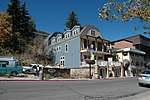William Austin House (Park City, Utah)
1890 establishments in Utah TerritoryHouses completed in 1890National Register of Historic Places in Summit County, UtahUtah Registered Historic Place stubs

The William Austin House, at 247 Ontario Ave. in Park City, Utah was built around 1890. It was listed on the National Register of Historic Places in 1984.It, among a group of 17 buildings, was deemed "architecturally significant as one of 78 extant T/L cottages in Park City".
Excerpt from the Wikipedia article William Austin House (Park City, Utah) (License: CC BY-SA 3.0, Authors, Images).William Austin House (Park City, Utah)
McHenry Street,
Geographical coordinates (GPS) Address Nearby Places Show on map
Geographical coordinates (GPS)
| Latitude | Longitude |
|---|---|
| N 40.642222222222 ° | E -111.49222222222 ° |
Address
McHenry Street 100
84060
Utah, United States
Open on Google Maps








